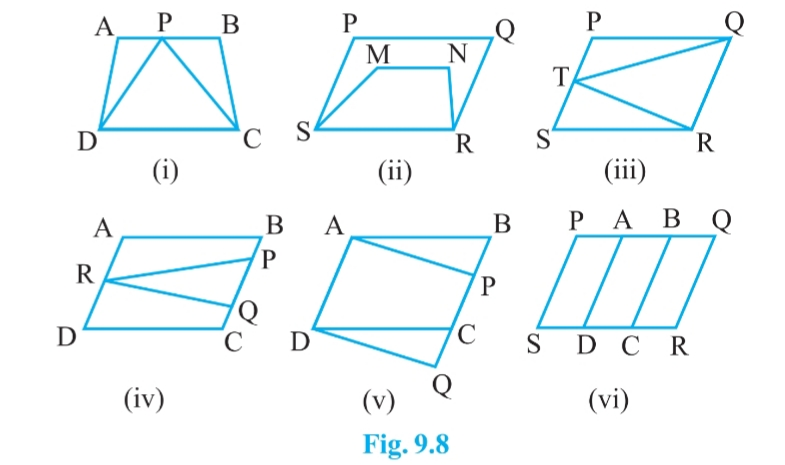NCERT Solutions for Exercise 9.1 Class 9 Maths Chapter 9 - Areas Of Parallelograms And Triangles
NCERT Solutions for Class 9 Maths exercise 9.1 - The properties of parallelograms on the same base and between the same parallels are identified in NCERT solutions for Class 9 Maths chapter 9 exercise 9.1. It includes questions about the diagonal of a parallelogram, its base, side lengths, area, and other unique properties of parallelograms. More such properties of this geometric shape are addressed in this NCERT exercise. Class 9 Maths chapter 9 exercise 9.1 two shapes are stated to be on the common base and between the same parallels if: A side is common between two shapes. The vertices opposite the same side and the sides parallel to the common base are both on the same straight line parallel to the base.
This Story also Contains
- Areas Of Parallelograms And Triangles Class 9 Chapter 9 Exercise: 9.1
- More About NCERT Solutions for Class 9 Maths Exercise 9.1
- NCERT Solutions of Class 10 Subject Wise
- Subject Wise NCERT Exemplar Solutions
If two shapes are congruent then the amount of area occupied by them will also be equal but the vice-versa of this statement is not true i.e. two figures having the same area need not be congruent.
A parallelogram is a geometrical shape with sides that are parallel to each other in two dimensions. It's a four-sided polygon (also known as a quadrilateral) with two parallel sides that are the same length. A parallelogram's interior opposite angles are also equal. The sum of a parallelogram's adjacent angles is 180 degrees.
- Areas of Parallelograms And Triangles Exercise 9.2
- Areas of Parallelograms And Triangles Exercise 9.3
- Areas of Parallelograms And Triangles Exercise 9.4
Areas Of Parallelograms And Triangles Class 9 Chapter 9 Exercise: 9.1

Answer:
In figure (i), (iii) and (v) we can see that. they lie on the same base and between the same parallel lines.
In figure (i) figure (iii) figure (v)
Common base DC QR AD
Two parallels DC and AB QR and PS AD and BQ
More About NCERT Solutions for Class 9 Maths Exercise 9.1
Area of the parallelogram are equals if they have a common base and between the same parallel line. We can also prove this property mathematical because we know that formula of the area of a parallelogram is the product of base and height. Since we have a base in the same and the distance between two parallel lines remains the same so the height is also the same.
The same theorem also applies to the triangles. Triangles with an equal area are those that have the same or common base and are connected by the same parallels.
Also Read| Areas Of Parallelograms And Triangles Class 9 Notes
Benefits of NCERT Solutions for Class 9 Maths Exercise 9.1
Exercise 9.1 Class 9 Maths, is based on the AREAS OF PARALLELOGRAMS AND TRIANGLES by providing a general approach to calculate the area.
Class 9 Maths chapter 9 exercise 9.1 introduces us to a new concept of parallelograms on the same base and between the same parallels
Understanding the concepts from Class 9 Maths chapter 9 exercise 9.1 will allow us to understand the concepts related to AREAS OF PARALLELOGRAMS AND TRIANGLEs which are yet to come in the further exercise.
Also, See
NCERT Solutions of Class 10 Subject Wise
Subject Wise NCERT Exemplar Solutions
Popular Questions
Courses After 12th
Applications for Admissions are open.
As per latest syllabus. Physics formulas, equations, & laws of class 11 & 12th chapters
JEE Main Important Chemistry formulas
Get nowAs per latest syllabus. Chemistry formulas, equations, & laws of class 11 & 12th chapters
JEE Main high scoring chapters and topics
Get nowAs per latest 2024 syllabus. Study 40% syllabus and score upto 100% marks in JEE
JEE Main Important Mathematics Formulas
Get nowAs per latest syllabus. Maths formulas, equations, & theorems of class 11 & 12th chapters
